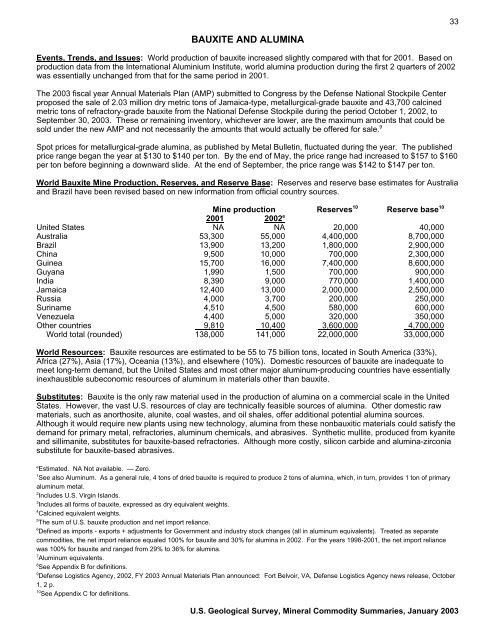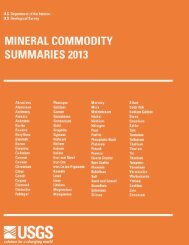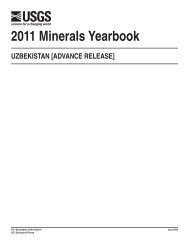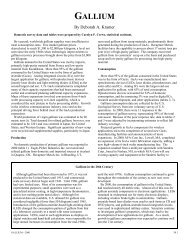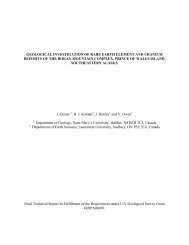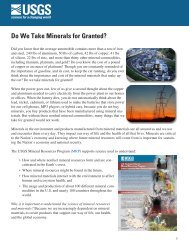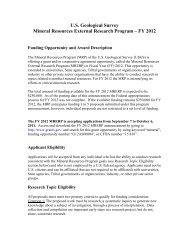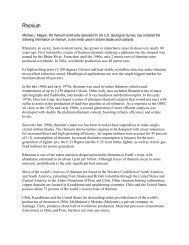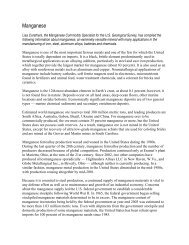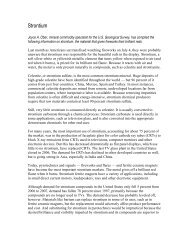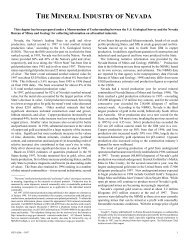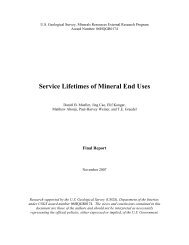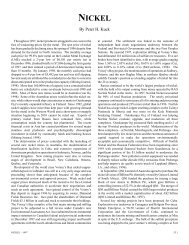Mineral Commodity Summaries 2003 - Mineral Resources Program ...
Mineral Commodity Summaries 2003 - Mineral Resources Program ...
Mineral Commodity Summaries 2003 - Mineral Resources Program ...
You also want an ePaper? Increase the reach of your titles
YUMPU automatically turns print PDFs into web optimized ePapers that Google loves.
BAUXITE AND ALUMINA<br />
Events, Trends, and Issues: World production of bauxite increased slightly compared with that for 2001. Based on<br />
production data from the International Aluminium Institute, world alumina production during the first 2 quarters of 2002<br />
was essentially unchanged from that for the same period in 2001.<br />
The <strong>2003</strong> fiscal year Annual Materials Plan (AMP) submitted to Congress by the Defense National Stockpile Center<br />
proposed the sale of 2.03 million dry metric tons of Jamaica-type, metallurgical-grade bauxite and 43,700 calcined<br />
metric tons of refractory-grade bauxite from the National Defense Stockpile during the period October 1, 2002, to<br />
September 30, <strong>2003</strong>. These or remaining inventory, whichever are lower, are the maximum amounts that could be<br />
sold under the new AMP and not necessarily the amounts that would actually be offered for sale. 9<br />
Spot prices for metallurgical-grade alumina, as published by Metal Bulletin, fluctuated during the year. The published<br />
price range began the year at $130 to $140 per ton. By the end of May, the price range had increased to $157 to $160<br />
per ton before beginning a downward slide. At the end of September, the price range was $142 to $147 per ton.<br />
World Bauxite Mine Production, Reserves, and Reserve Base: Reserves and reserve base estimates for Australia<br />
and Brazil have been revised based on new information from official country sources.<br />
Mine production Reserves 10<br />
Reserve base 10<br />
2001 2002 e<br />
United States NA NA 20,000 40,000<br />
Australia 53,300 55,000 4,400,000 8,700,000<br />
Brazil 13,900 13,200 1,800,000 2,900,000<br />
China 9,500 10,000 700,000 2,300,000<br />
Guinea 15,700 16,000 7,400,000 8,600,000<br />
Guyana 1,990 1,500 700,000 900,000<br />
India 8,390 9,000 770,000 1,400,000<br />
Jamaica 12,400 13,000 2,000,000 2,500,000<br />
Russia 4,000 3,700 200,000 250,000<br />
Suriname 4,510 4,500 580,000 600,000<br />
Venezuela 4,400 5,000 320,000 350,000<br />
Other countries 9,810 10,400 3,600,000 4,700,000<br />
World total (rounded) 138,000 141,000 22,000,000 33,000,000<br />
World <strong>Resources</strong>: Bauxite resources are estimated to be 55 to 75 billion tons, located in South America (33%),<br />
Africa (27%), Asia (17%), Oceania (13%), and elsewhere (10%). Domestic resources of bauxite are inadequate to<br />
meet long-term demand, but the United States and most other major aluminum-producing countries have essentially<br />
inexhaustible subeconomic resources of aluminum in materials other than bauxite.<br />
Substitutes: Bauxite is the only raw material used in the production of alumina on a commercial scale in the United<br />
States. However, the vast U.S. resources of clay are technically feasible sources of alumina. Other domestic raw<br />
materials, such as anorthosite, alunite, coal wastes, and oil shales, offer additional potential alumina sources.<br />
Although it would require new plants using new technology, alumina from these nonbauxitic materials could satisfy the<br />
demand for primary metal, refractories, aluminum chemicals, and abrasives. Synthetic mullite, produced from kyanite<br />
and sillimanite, substitutes for bauxite-based refractories. Although more costly, silicon carbide and alumina-zirconia<br />
substitute for bauxite-based abrasives.<br />
e<br />
Estimated. NA Not available. — Zero.<br />
1<br />
See also Aluminum. As a general rule, 4 tons of dried bauxite is required to produce 2 tons of alumina, which, in turn, provides 1 ton of primary<br />
aluminum metal.<br />
2<br />
Includes U.S. Virgin Islands.<br />
3<br />
Includes all forms of bauxite, expressed as dry equivalent weights.<br />
4<br />
Calcined equivalent weights.<br />
5<br />
The sum of U.S. bauxite production and net import reliance.<br />
6<br />
Defined as imports - exports + adjustments for Government and industry stock changes (all in aluminum equivalents). Treated as separate<br />
commodities, the net import reliance equaled 100% for bauxite and 30% for alumina in 2002. For the years 1998-2001, the net import reliance<br />
was 100% for bauxite and ranged from 29% to 36% for alumina.<br />
7<br />
Aluminum equivalents.<br />
8<br />
See Appendix B for definitions.<br />
9<br />
Defense Logistics Agency, 2002, FY <strong>2003</strong> Annual Materials Plan announced: Fort Belvoir, VA, Defense Logistics Agency news release, October<br />
1, 2 p.<br />
10 See Appendix C for definitions.<br />
U.S. Geological Survey, <strong>Mineral</strong> <strong>Commodity</strong> <strong>Summaries</strong>, January <strong>2003</strong><br />
33


